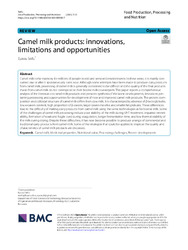| dc.contributor.author | Tselaesele, Nelson | |
| dc.contributor.author | Seifu, Eyassu | |
| dc.contributor.author | Molapisi, Moenyane | |
| dc.contributor.author | Boitumelo, Wame | |
| dc.contributor.author | Angassa, Ayana | |
| dc.contributor.author | Kgosikoma, Keneilwe | |
| dc.contributor.author | Teketay, Demel | |
| dc.contributor.author | Sekwati-Monang, Bonno | |
| dc.contributor.author | Chimbombi, Ezekiel | |
| dc.contributor.author | Kobue-Lekalake, Rosemary | |
| dc.contributor.author | Bultosa, Geremew | |
| dc.contributor.author | Haki, Gulelat Desse | |
| dc.contributor.author | Witness, Mojeremane | |
| dc.contributor.author | Kgaudi, Katsane | |
| dc.contributor.author | Mokobi, Boitumelo | |
| dc.date.accessioned | 2022-07-06T10:00:18Z | |
| dc.date.available | 2022-07-06T10:00:18Z | |
| dc.date.issued | 2021 | |
| dc.identifier.citation | Mojeremane, K. K., & Mokobi, B. Perceptions and attitudes of communities on socio-economic importance of camels and consumption of camel milk and camel milk products in Kgalagadi District, Botswana.Journal of Camelid Science 2021, 14 (1): 52-66 | en_US |
| dc.identifier.issn | 199998732 | |
| dc.identifier.uri | http://www.isocard.net | |
| dc.identifier.uri | https://hdl.handle.net/13049/493 | |
| dc.description.abstract | Camels were introduced to Botswana in the early twentieth century as a means of transport for
the Botswana Police Service in the Kgalagadi District. This service was discontinued in the early 1980s
and the camels were handed over to communities in the district for ecotourism activities. Since their
introduction in Botswana, camels were regarded as government property and were never taken as
alternative livelihood option that can alleviate poverty by providing milk and other products as is the
case in other countries. This study explores the prospects of utilization of camel milk and milk products
by assessing perceptions and attitudes of communities on the socio-economic importance of camels,
consumption preferences for camel milk and value-added milk products. A combination of qualitative
and quantitative methods was used to address the objectives of the research. This included a focus group
discussion and a structured questionnaire that were used to determine the perceptions and attitudes of
participants towards camels, camel milk and camel milk products. The strengths and opportunities
associated with production of camel milk and milk products were higher than the weakness and threats;
the respondents appreciated camel milk and milk products as weighed against their socio-cultural
practices. The majority of the respondents would consume camel milk and milk products though not on
a daily basis. There is no socio-cultural factor that hinders the use of camel milk and camel milk
products and raising camels in the Kgalagadi District; the respondents had a positive attitude towards
camels, camel milk and milk products. | en_US |
| dc.language.iso | en | en_US |
| dc.publisher | International Society of Camelid Research and Development | en_US |
| dc.relation.ispartofseries | Journal of Camelid Science 2021;14 (1): 52-66 | |
| dc.subject | Kgalagadi | en_US |
| dc.subject | Botswana | en_US |
| dc.subject | Camel milk | en_US |
| dc.subject | Perception | en_US |
| dc.subject | Attitudes | en_US |
| dc.subject | Dromedary camels | en_US |
| dc.subject | Socio-cultural factors | en_US |
| dc.title | Perceptions and attitudes of communities on socio-economic importance of camels and consumption of camel milk and camel milk products in Kgalagadi District, Botswana. | en_US |
| dc.type | Article | en_US |




